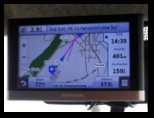









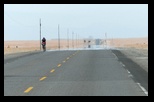

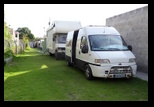


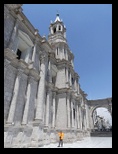




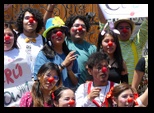

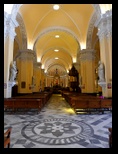

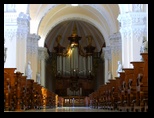






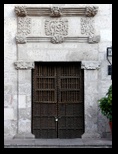
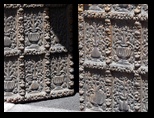
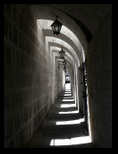




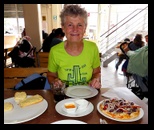
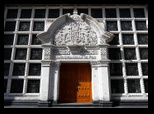


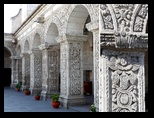

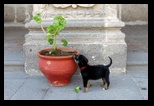
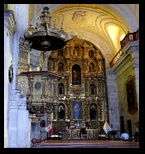


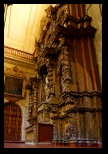




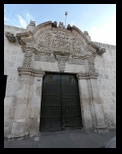







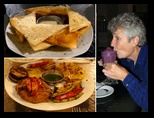

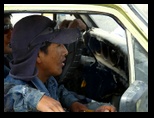

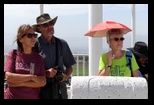

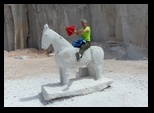

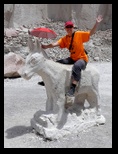


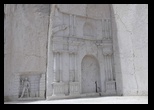

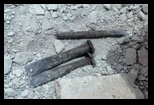












Click on a photo to enlarge it.
14. - 15.11.2019: Pan-American Highway from Arica to Arequipa
The border crossing into Peru took just over an hour but it was a really complicated process. We queued up but once we got to the window we were told we needed to fill in a form first! So the man behind the window took us through to a different part of the building where a woman gave us a form. We filled it in and went back to wait for the same man to deal with us.
The form had 4 copies for:- 1. exit Chile passports; 2. entry Peru passports; 3. exit Chile vehicle permit cancellation; 4. entry Peru vehicle permit.
We managed to get through to number 4 only to find we were in the wrong queue. It was just for South American vehicles. We had to go around the side of the building to a different office but then had to go back because our 4th piece of paper had been taken off us by mistake at the South American vehicle window!
Then we were stopped as we tried to drive through to the vehicle inspection because only the driver is allowed in the vehicle! So Kirsten had to get out and walk through the building and wait for me at the other side! I drove to the vehicle inspection and two officers went inside and started knocking every single surface/cupboard and checking everything. A far more thorough check than we've had for a long time. Do we look suspicious??
Finally we got through, Kirsten hopped back in, we drove out and stopped at an office to buy vehicle insurance. We'll be returning to Peru on our way south again and we found that it was cheaper to buy one year's cover rather than two times 1 month! Good job we could pay by visa as there was nowhere at the border to change money and no banks or ATMs. It only cost us $27 US for a year!
Our route took us along the coast through sand dunes and barren desert. Nothing and no one to be seen. Strangely we saw areas where land parcels next to the road were partitioned off using rocks and stones. People had even tried planting trees to use as partitions. How on earth they would grow in this arid and barren desert is a puzzle!!
There were even brick structures the size of a garden shed every so often alongside the road, which is also the Pan-American Highway. Very strange! The highway went up 1,200m into the hills and into thick fog. Then back down to Moquegua where we parked at a relatively quiet petrol station for the night.
The next morning we made the mistake of following our GPS into town to find a bank. For some reason it took us through narrow steep streets, where we had to mount the pavement to get through and tried to get us to turn the wrong way into one way streets!!!
We found a far easier way out of the town later but we needed cash - Peruvian Soles. So I parked in a spot somewhere close to a bank and Kirsten went off to get us cash. At the bank she asked for Bolivianos!! For some reason she thought we were in Bolivia but we're in Peru!! Fortunately they didn't have any so she used an ATM and got the correct currency out!!
We got out of town very easily without following our GPS and got back onto the Pan-American Highway through barren desert and uphill through fog again. We didn't even need our new cash for tolls because the three we went through were free for north bound traffic.
We joined a very busy narrow road uphill to Arequipa which was full of lorries that were difficult to overtake and then had a problem getting into a campground very near the town centre. The entrance was on a bend of a busy dual carriageway and we had to ring the bell to get someone to open the gate to let us in. I thought we would get hit by traffic whizzing around the corner and I had to reverse to make it through the gate!!
The campground is at a hostal and all the RVs have to park in a single line next to the wall. No room to manoeuvre but at least there is another gate to exit at the far end because we'd never be able to turn around. We were only going to stay for 2 or 3 nights but, as always, our plans changed and we stayed for 5 nights. The campground had everything we needed including hot showers and a supermarket virtually next door which was very handy because we needed supplies.
16. - 20.11.2019: Arequipa & Half day trip to the Ruta Del Sillar
Founded in 1540 Arequipa is the second largest city in Peru after the capital Lima and has just over 1 million inhabitants. It is 2328m above sea level and is a Unesco World Heritage Site. It is also called the White City because of the white buildings in the colonial centre.
We were in Arequipa 17 years ago but couldn't visit the cathedral because it had been damaged by an earthquake where one of the towers had collapsed and it was closed for repairs. So our aim was to get in to see the cathedral, but that proved harder than we thought. We'd arrived on a Friday and somehow managed to be in town when it was closed. Ah, but surely it would be open on a Sunday evening. Even the tourist police told us it would open at 6-30pm .... but no!! So it wasn't until we'd been in town for three nights that we finally got inside to see it!
It had certainly been impressively rebuilt and we also enjoyed wandering around the colonial city looking at other churches and lovely little courtyards. We were clocking up a lot of miles just walking around to see everything!
We spent a lot of time chatting to other campers who were all heading south and gave them lots of tips, passing on films and ebooks. We spontaneously extended our stay when I stopped to look at photos on the windows of a tour office. We signed up for a tour called La Ruta del Sillar the next day to see the quarry where the white stones for the cathedral and other colonial buildings came from.
When we got back to the campground we told our neighbours, Monika and Georg, who decided to come with us. We got picked up from the hostal at 8-20am the following morning and got into a minibus with a driver and Joel, our guide. There were 13 of us altogether, the four of us plus 9 others from Poland, Taiwan, Mexico, one other German and 5 from Peru.
We did a little tour around Arequipa picking up other passengers and went past some nice colonial buildings. We noted the street names and walked there the next day for photos. Our first stop on the tour was a viewpoint above Arequipa with some stone sculptures from the volcanic layers deposited from various eruptions of the Chachani volcano during the Pleistocene era. Sillar is composed of Rhyolite and the pink variety is caused by crystals of hematite in the rock.
A large group of very noisy school children turned up which was our cue to leave!! Then we drove to a quarry and took photos of a sculpted rock face that reminded us of Petra in Jordan. Well ... a much smaller version of course but still impressive.
 Sillar quarry outside of Arequipa - 360° Panorama
Sillar quarry outside of Arequipa - 360° Panorama
(move mouse over panorama and click on the arrows)
We also got to see some men cutting the rock into slabs and took photos and video of man up on the quarry edge, shoving the top layer down into the base of the quarry!! He produced clouds of rock dust ... not exactly very healthy to breathe in!! Then the school bus turned up ... so we left.
Our next stop was to see another man cutting slabs and demonstrating the process that has been handed down through his family. Only those whose family members did the cutting in the past are allowed to work here. It was interesting to watch. He only gets 5 Soles per block (approx $1-50).
Our final stop was the Quebrada de Culebrillas, a narrow slot canyon, part of which is protected. It was only a short 20 minute walk through the canyon to some petroglyphs but the school kids followed us. So we climbed back out, got back into our minibus and got dropped off in the centre of Arequipa at 1pm. We thoroughly enjoyed the tour because it was something we hadn't seen 17 years ago and we probably wouldn't have driven there ourselves. Certainly worth the 35 Soles each ($10-70).
The White City made from white sillar slabs
We picked up some more cash from an ATM and then went to a large indoor fruit and veg market to buy supplies. Back at the campground I did some hand washing which I hung up in the front drivers cabin and we watched some football highlights of the European qualification matches. I had to look up some words on the internet from our tour because I had difficulty understanding our guide's English. I learned far more from his Spanish!!
Before driving out of Arequipa the next day, we walked to the colonial buildings we'd passed at the start of the tour for photos and then filled up with water etc. Kirsten also transferred a lot of ebooks and films for Monika and Georg and we said goodbye to them. It was 3pm before we left but we still had enough time to drive back down to the coast for the night.
We'd really enjoyed our time there and were really glad that the centre of Arequipa had retained it's colonial beauty. Unfortunately we were about to find out that other places we'd seen 17 years ago would be completely changed in a negative way!